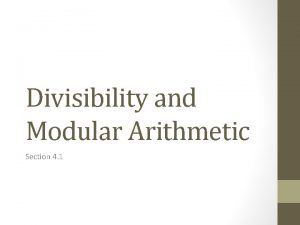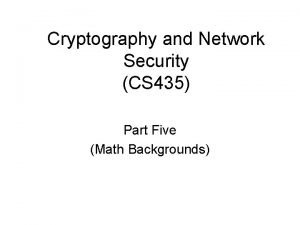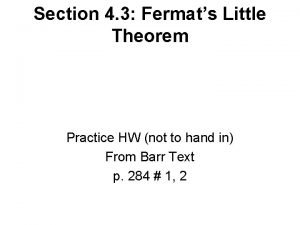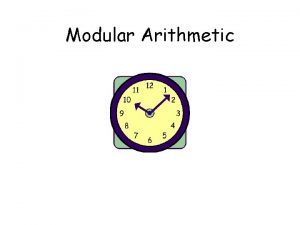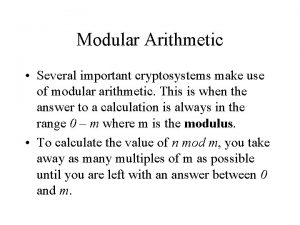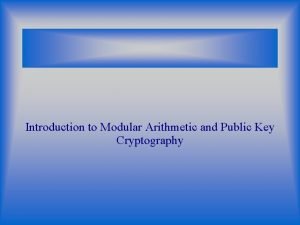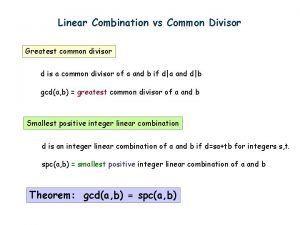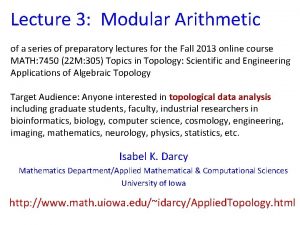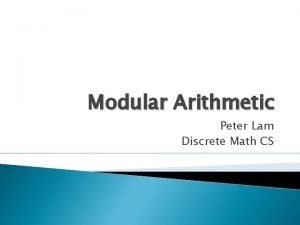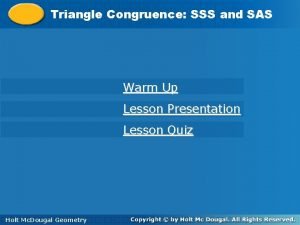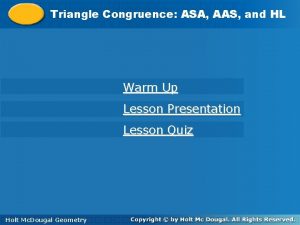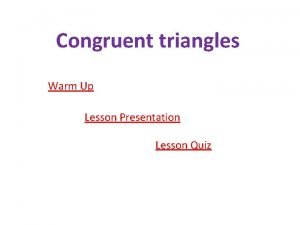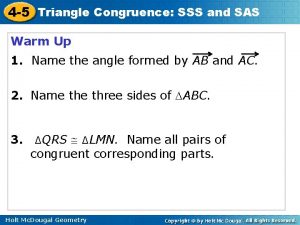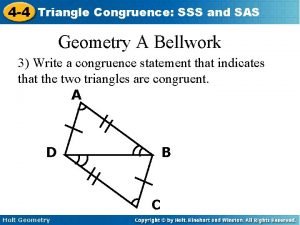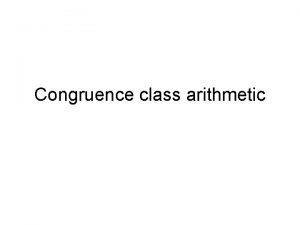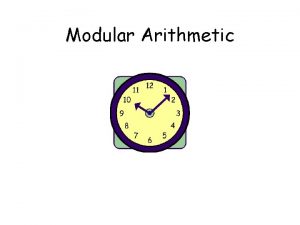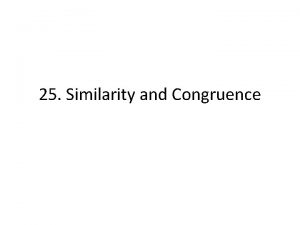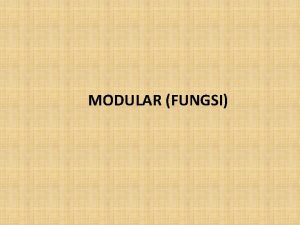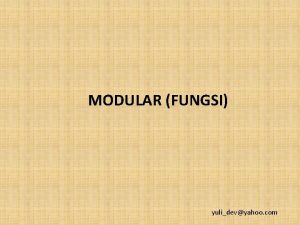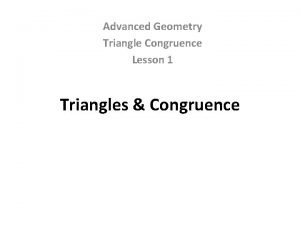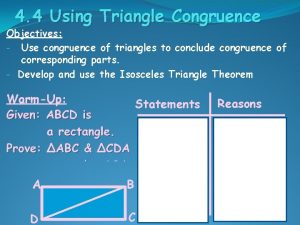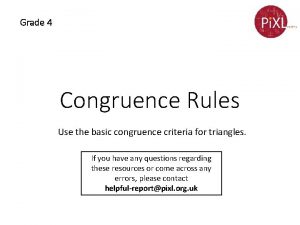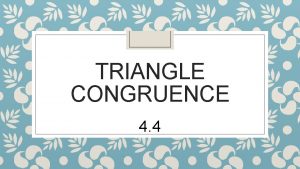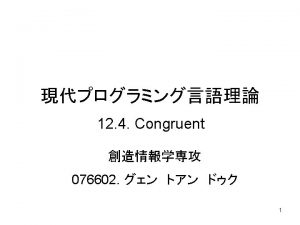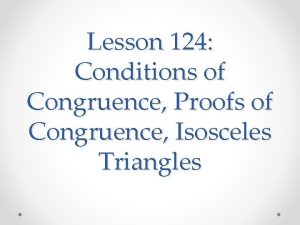CONGRUENCES AND MODULAR ARITHMETIC Congruence and Modular Arithmetic















- Slides: 15

CONGRUENCES AND MODULAR ARITHMETIC

Congruence and Modular Arithmetic Definition: a is congruent to b mod n means that n∣a-b, (a-b) is divisible by n. Notation: a ≡ b (mod n) Ex. Since, , a, b, n ∈ I, n ≠ b 42 ≡ 30 (mod 3) 3 ∣ 42 – 30 a ≡ b (mod n), it means that n ∣ a – b Ex. 3 ≡ 4 (mod 5)

Congruence and Modular Arithmetic If two numbers a and b have the property that their difference a-b is divisible by a number n (ex. (a-b) ∣ n is an integer), then a and b are said to be "congruent modulo n. " The number n is called the modulus, and the statement "a is congruent to b (modulo n)" is written mathematically as a ≡ b (mod n)

Congruence and Modular Arithmetic If a – b is not divisible by n, then it is said that "a is not congruent to b (modulo n), " which is written as a ≡ b (mod n)

Proposition: Congruence mod m is an equivalent relation: Equivalence relation is a reflexive (every element is in the relation to itself), symmetric (element a has the same relation to element b that b has to a), and transitive (a is in a given relation to b and b is in the same relation to c, then a is also in that relation to c) relationship between elements of a set. Proposition: Any relation is called an equivalence relation if it satisfied the following properties:

Proposition 1. Reflexivity (every element is in the relation to itself) a ≡ a (mod n) for all a Ex. 3 ≡ 3 (mod 5) 2. Symmetry (element A has the same relation to element B that B has to A), If a ≡ b (mod n), then b ≡ a (mod n) Ex. 10 ≡ 7 (mod 3), then 7 ≡ 10 (mod 3) 3. Transitivity If a ≡ b (mod n) and b ≡ c (mod n), then a ≡ c (mod n) Ex. 20 ≡ 4 (mod 8), then 4 ≡ 12 (mod 8), then 20 ≡ 12 (mod 8)

Properties 1. Equivalence: a ≡ b (mod 0) → a ≡ b (which can be regarded as a definition) Ex. 18 ≡ 6 (mod 0) 0 ∣ 18 – 6 2. Determination: either a ≡ b (mod n) or a ≡ b (mod n) Ex. 3. Reflexivity: Ex. 30 ≡ 3 (mod 9) 9 ∣ 30 – 3 a ≡ a (mod n) 7 ≡ 7 (mod 1) 1∣ 7– 7 or 14 ≡ 5 (mod 2) 2 ∣ 14 – 5

Properties 4. Symmetry: a ≡ b (mod n), then b ≡ a (mod n) Ex. 20 ≡ 2 (mod 6), then 2 ≡ 20 (mod 6) 6 ∣ 20 – 2 , then 6 ∣ 2 – 20 5. Transitivity: a ≡ b (mod n) and b ≡ c (mod n), then a ≡ c (mod n) Ex. 16 ≡ 4 (mod 2) and 4 ≡ 8 (mod 2), then 16 ≡ 8 (mod 2) 2 ∣ 16 – 4 and 2 ∣ 8 – 4 , then 2 ∣ 16 – 8 6. a ≡ b (mod n) → (k)a ≡ (k)b (mod n) Ex. 25 ≡ 5 (mod 10) → (2)25≡ (2)5 (mod 10) 10 ∣ 25 – 5 → 10 ∣ 50 – 10

Properties 7. a ≡ b (mod n) → am ≡ bm (mod n), n ≥ 1 Ex. 42 ≡ 12 (mod 3) 3 ∣ 16 – 1 8. a ≡ b (mod n 1) and a ≡ b (mod n 2) → a ≡ b (mod [n 1, n 2] ), where [n 1, n 2] is the LCM Ex. 15 ≡ 3 (mod 4) and 15 ≡ 3 (mod 6) → 15 ≡ 3 (mod [4, 6] ) → 15 ≡ 3 (mod 12) → 12 ∣ 15 – 3

Properties n 9. ak ≡ bk (mod n) → a ≡ b (mod (k, n) ), where (k, n) is the HCF Ex. 2 ) (4, 2) → 15 ≡ 13 (mod 2 ) 2 15 (4) ≡ 13 (4) (mod 2) → 15 ≡ 13 (mod 60 ≡ 52 (mod 2) → 15 ≡ 13 (mod 1) 2 ∣ 60 – 52 → 1 ∣ 15 – 13

EXERCISE !!

Excersise 1. Give an example for transitivity property “a ≡ b (mod n) and b ≡ c (mod n), then a ≡ c (mod n)”. 2. Find 3 numbers of “a” a ≡ 10 (mod 3), then 10 ≡ a (mod 3) 3. Find x 24 ≡ 8 (mod x), then 8 ≡ 18 (mod x), then 24 ≡ 18 (mod x) 4. Find 3 numbers of “b”. 38 ≡ b (mod 3) → (2)38≡ (2)b (mod 3)

Excersise 5. True or False 283 ≡ 53 (mod 3) 383 ≡ 53 (mod 3) 255 ≡ 6 (mod 7) 6. Solve the following. 42 ≡ 6 (mod 4) and 42 ≡ 6 (mod 9) 23 (12) ≡ 15 (12) (mod 4) 32 2 ≡ 83 (mod 6)

THANK YOU

Submitted by: EP 4/1 Group 3 Chosita K. “ 2” Hsinju C. “ 3” Nipawan P. “ 5” Ob-Orm U. “ 11” Submitted to: Mr. Wendel Glenn Jumalon
 Divisibility and modular arithmetic
Divisibility and modular arithmetic Modular arithmetic in cryptography and network security
Modular arithmetic in cryptography and network security Fermat's little theorem
Fermat's little theorem Lesson note on modular arithmetic
Lesson note on modular arithmetic Modular inverse
Modular inverse Modular arithmetic
Modular arithmetic How to find multiplicative inverse
How to find multiplicative inverse Gcd linear combination
Gcd linear combination Modular arithmetic
Modular arithmetic Modular arithmetic discrete math
Modular arithmetic discrete math 4-5 triangle congruence sss and sas
4-5 triangle congruence sss and sas Triangle congruence hl
Triangle congruence hl Can you use the sss postulate or the sas postulate to prove
Can you use the sss postulate or the sas postulate to prove Quiz 4-2 congruent triangles
Quiz 4-2 congruent triangles Triangle congruence sss and hl quiz
Triangle congruence sss and hl quiz 4-4 triangle congruence sss and sas
4-4 triangle congruence sss and sas
